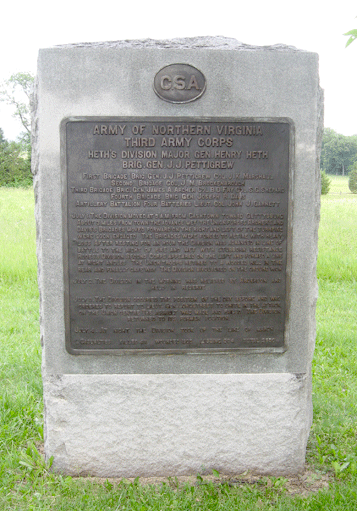Confederate Headquarters Markers > Hill’s 3rd Corps
The monument to Heth’s Division of the Third Corps is southwest of Gettysburg on West Confederate Avenue. (West Confederate Avenue – Pt. 2 tour map)
Heth’s Division in the Gettysburg Campaign
Heth’s Division started the Battle of Gettysburg when it marched from Cashtown in the morning of July 1st and ran into Union cavalry at Marsh Creek. Lee had ordered Heth to avoid a general engagement, but skirmishing with cavalry did not count. But suddenly infantry from the Army of the Potomac was tearing into Heth’s two lead brigades. Brigadier General James Archer was captured, as was part of Davis’s Brigade. Lee reached the front and gave his blessing to the developing battle when Confederate reinforcements appeared on the Union flank and rear, and Heth’s Division found itself in the center of the first day’s fighting.
The division’s casualties were heavy and on July 2nd it was held in reserve. Heth himself narrowly escaped a serious head wound. Paper padding an aide had placed in his new hat to help with its fit probably saved Heth’s life, but he was out of the battle. Brigadier General J. J. Pettigrew took over the division. On July 3rd the rested division took part in the attack that would be known as Pickett’s Charge. Led by Pettigrew, it again took heavy casualties, giving the division the highest losses of any at Gettysburg.
Heth’s Division had one last bit of bad luck in the campaign. Pettigrew and the division were the rear guard as Lee’s Army made its way to safety across the swollen Potomac. Before they could cross, Union cavalry made a wild attack. It had little result other than mortally wounding Pettigrew, one of the most promising younger officers in the army.

Monument to Heth’s Division of the Army of Northern Virginia at Gettysburg
From the monument
C. S. A.
Army of Northern Virginia
Third Army Corps
Heth’s Division
Major Gen. Henry Heth Brig. Gen. J. J. Pettigrew
First Brigade Brig. Gen. J. J. Pettigrew
Col. J. K. Marshall
Second Brigade Col. J. M. Brockenbrough
Third Brigade Brig. Gen. James A. Archer*
Col. B. D. Fry
Col. S. G. Shepard
Fourth Brigade Brig. Gen. Joseph R. Davis
Artillery Brigade
Four Batteries Lieut. Col. John J. Garnett
July 1. The Division moved at 5 A. M. from Cashtown toward Gettysburg. About 3 miles from town the advance met the Union Forces. Archer’s and Davis’ Brigades moved forward on the right and left of the turnpike were soon engaged. The Brigades were forced to retire with heavy loss. After resting for an hour the Division was advanced in line of battle to the right of the pike and met with stubborn resistance. Rodes’ Division Second Corps appeared on the left and formed a line at right angles. The Union troops retired to a wooded hill in the rear and finally gave way. The Division bivouacked on the ground won.
July 2. The Division in the morning was relieved by Anderson and held in reserve.
July 3. The Division occupied the position of the day before and was ordered to report to Lieut. Gen. Longstreet to unite in the attack on the Union centre. The assault was made and failed. The Division returned to its former position.
July 4. At night the Division took up line of march.
*Note: Archer’s middle initial is “J,” not “A” as on the monument.
About Henry Heth
The division was commanded at Gettysburg by Henry Heth, a career army officer from Virginia. He was the son of a captain in the U.S. Navy and grandson of a colonel in the Revolution. George Pickett was his cousin. Heth graduated in the West Point Class of 1847, last in his class like his cousin the year before. Heth joined the 1st Infantry, serving on the western frontier. In 1855 he was promoted to captain, and in September of that year took part in the Battle of Ash Hollow, labeled at the time a massacre of mostly women and children of the Brule Sioux.
At the start of the Civil War Heth returned to Virginia. He was sent to Wytheville in what is now West Virginia to train the militia gathering there. He formed the 45th Virginia Infantry Regiment and on May 29, 1861 became its colonel. He was frustrated both by his undisciplined backwoods farmers and his incompetent commander, Brigadier General John B. Floyd. He led his regiment at Cross Lanes and Carnifax Ferry, suffering but three casualties in the Confederate retreat. For a short time Robert E. Lee arrived to take command in the troubled theater, and Heth became good friends with him while serving as his quartermaster. Heth was one of the few officers Lee called by his first name.
In December of 1862 Heth took command of his brigade, and was promoted to brigadier general in January. In August of 1862 he was transferred to the to the Department of East Tennessee for the Kentucky Campaign. He lead a division in a feint on Cincinatti before Bragg ordered a withdrawal back to Tennessee. In March of 1863 Heth was recalled back east and given a brigade in A.P. Hills division, which he commanded at Chancellorsville. The division became part of Hill’s 3rd Corps when it formed.
Location of the monument to Heth’s Division
The monument is southwest of Gettysburg on the west side of West Confederate Avenue. It is about .08 mile south of the intersection with Middle Street, and across from the State of North Carolina monument. (39°49’07.0″N 77°14’51.9″W)

